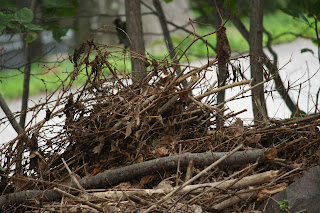Creating a Backyard Habitat
If you're reading this, I doubt we need to talk about why you should want to turn your backyard into a wildlife habitat. But just in case you need some extra motivation, this article we wrote earlier this year explains a few cost-saving and back-saving reasons!
First of all, you don't have to have a forest in your backyard or a wetland moat around your house to have a backyard habitat. You'll be surprised how little you have to add to your yard to help in huge ways!
I'm going to jump on a soap box for just a moment here: when we say "wildlife," we are not being exclusive. We are not saying, "Okay all the cute birds and butterflies but NO BEES and NO GROUNDHOGS." The truth is, no matter what wild critter it is (even bugs!), they are all necessary parts of our ecosystem, and it is a true compliment when they visit our yards. If you're more inclined to invite wildlife in -- but with exceptions, then habitat creation may not be for you. Okay, off my soap box now!
Let's break down what a viable habitat has and some ways to add them to your yard. We'll break the steps into "Beginner" and "Advanced" versions, so you can tackle what fits your wallet and your ability!
Shelter
What It Is:
Shelter is important to hide small critters from predators, to provide shelter from weather, or to provide a place to raise little critters. The brush pile pictured above is great shelter for insects (which birds obviously love to munch on). Thick coniferous trees or shrubs are great for bird perches. Artificial shelters like bird houses or bat houses work well too!
Beginner Plan:
Plant a shrub like Service Berry or a coniferous tree or shrub like Norway Spruce. Placing groups of these plants together will provide a great wind break as well as help birds and insects go from plant to plant.
Advanced Plan:
Mimic the diversity of a natural ecosystem in your plantings-- open sections of wild flowers, tall deciduous trees, groupings of coniferous trees, and smaller trees like red buds with low canopies.
Create brush piles away from view. In the fall, let the leaves in your yard create a nurturing leaf litter.
Food
What It Is:
When we think of nurturing wildlife in our yards, feeding them is often what comes to mind first. Almost everyone and their cousin has at least one bird feeder hanging up! Providing food in habitat goes well beyond throwing out bird seed, however. After all, you don't see cracked corn scattered on the forest floor, do you?
Providing natural sources of food as well as "supplemental" sources (i.e. bird seed) is important. So what do birds and other critters eat naturally? Seeds from flowers such as coneflowers, insects, fruit like that from a mulberry tree. Flowering plants feed a wide variety of critters, and having something blooming in your yard from March to October is ideal (and possible!).
Beginner Plan:
Put up a tray feeder with a bird seed mix (the most accommodating type for the most amount of birds). Keep it near some dense vegetation so that skittish birds can comfortably fly to the new feeder and back to safety quickly.
Plant native perennial plants like coneflower or a native fruit-bearing shrub like service berry. Birds, butterflies, bees, and even more will thank you!
Advanced Plan:
Set up bird feeding "stations" with a wide variety of seed. Throw some seed on the ground like white millet for ground-feeding birds; have tray feeders with whole peanuts; and provide fat-rich suet for clinging birds in the winter.
Plan your plantings so that there are flowers blooming from early spring to late fall. Insects will appreciate the prolific food, and you'll get quite a show with butterflies and hummingbirds too.
Water
What It Is:
For most of you reading this, this is probably the easiest part of habitat creation-- because you already have this! Your pond or pond-free waterfall is an ideal source of water for critters.
The most obvious use of water is for hydration and for birds to keep their feathers clean. But water is so much more important than that even. Water itself is a fantastic breeding ground for a whole host of beneficial insects, including our beloved dragonflies.
Not all water is created equally. The best water is not stagnant, which can collect harmful bacteria, but instead constantly moving. Having a variety of water depths in your water feature as well as some slower-moving pockets of water is great. Think of a natural creek or river. There are many different parts and functions to those natural water bodies, and yours should have them too. Not to toot our own horn or anything, but we're kind of experts at this! So if you need advice, we've got you covered.
Water is also just as important if not more so in winter. Although there might be snow on the ground, it takes a lot of caloric energy to melt a mouthful of snow into water, and it puts birds and mammals at risk of dehydration. Keeping a small section of your pond or pond-free free of ice will help out so much.
Beginner Plan:
Assuming you don't already have a water feature, add a bird bath with a water wiggler. This will keep the water agitated and fresh-- and free of mosquitoes!
Advanced Plan:
Keep a creek with a variety of depths and some slower moving pockets perfect for insect life and for bird bathing.
This is by no means a comprehensive list of all the ways to make your backyard a great habitat. In addition to asking us specific questions in the store or having us professionally install a habitat in your yard, we encourage you to check out the Indiana Wildlife Federation website. You can even get your yard officially certified as a wildlife habitat!






Comments